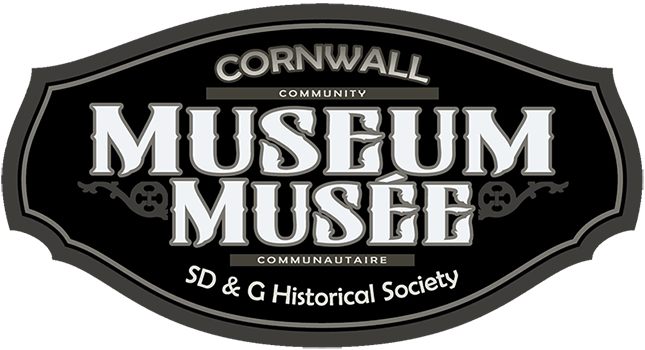Permanent Exhibits
1784: The Founding of Cornwall and SDG
As the earliest settlements in Ontario, this exhibit highlights artifacts related to the founding of Cornwall and the United Counties of SDG by Loyalist refugees in 1784. Displays of interest include Loyalist clothing, original Upper Canada land grants, and a large reproduction of the 1786 McNiff maps of Lancaster, Charlottenburg, Cornwall, Osnabruck, Williamsburg, and Matilda townships.
Black History in Upper Canada
This exhibit features the replica red coat British Army uniform of John Baker, registered as Canada’s last living formerly enslaved person, as well as story boards detailing the black history of Upper Canada. Of note are the stories of black loyalists, such as Cato Prime, and the history of slavery.
Indigenous History of Upper Canada (in development)
This exhibit, hosted in collaboration with the Native North American Travelling College, offers an introduction to the Indigenous History of Upper Canada, with an explicit focus on the Mohawks of Akwesasne and their ancestors.
The Cornwall Canal and St. Lawrence Seaway
Cornwall’s waterfront has changed dramatically over the years, marked first by the presence of the Long Sault Rapids, followed by the Cornwall Canal, and finally by the St. Lawrence Seaway and Power Project. This exhibit details the impacts of such changes to Cornwall’s waterfront over time.
Trades and Local Productions
This exhibit features displays on historic carpenters, blacksmiths, foundries, potteries, ice harvesting, dairies and creameries in our region, as well as kitchen wares spanning the course of more than a century, from approximately 1850 to 1950.
Industry
Cornwall is perhaps best known by its illustrious industrial past, boasting several industries such as a paper mill, cotton mills, a synthetic silk manufacturer, and an early street railway and power company, among others. This exhibit serves to highlight Cornwall’s industrial past by including displays on the historic paper mill (Domtar), Courtauld’s, the cotton mills, Canadian Industries Limited, and the Cornwall Street Railway Light and Power Company.
Retail & Commerce (in development)
Cornwall has featured numerous brick and mortar retail stores over the years and this exhibit aims to highlight several such historic businesses. Examples include Chalet artistic glass, Snetsinger’s Hardware, and La Reine Leblanc Millinery, among others.
1940s BEDROOM / BEACH FURNITURE
Our 1940s bedroom is equipped with authentic furnishings produced at the Beach furniture factory – once located at the corner of Sydney and Ninth Street - the sight of which is sure to generate cozy feelings from the past. In addition, most textiles on display were produced at one of Cornwall’s 4 historic cotton mills, one of which was the first building in the world to be lit by Thomas Edison’s lightbulb.Community Service
Our community service exhibit features social organizations such as the Masons, the Eastern Rebekah Star Lodge, and the Kinsmen/Kinettes, as well as public services such as the Cornwall Police and Fire Departments. Several of Cornwall’s past mayors are also on display in a representation of City Hall. Furthermore, we share a sizable collection of military artifacts representing the First and Second World Wars as well as other battles.
Healthcare
The healthcare exhibit shares the history of Cornwall’s first hospitals, pharmacies, as well as the schools of nursing. In addition, we feature some prominent doctors such as Williamsburg’s famous toe twister, Dr. Locke.
Significant Persons
Hosted in a furnished early 1900s study that includes an antique oak desk, fireplace, and studio camera, our significant persons' exhibit features a rotating cast of local characters who have made tremendous contributions to the development of our city and province. Such notable individuals include the former minister of transportation Lionel Chevrier, Cornwall’s first female city councilor Mary Mack, and Ontario’s 4th Lieutenant Governor Donald Alexander Macdonald, among others.
The Wood House – Heritage Property
Our museum is situated in the historic Wood House, which was built around 1840 by William Wood, a Loyalist descendant of Jonas and Sarah Wood. A wealth of information about the Wood family and other pioneers are housed within the museum. We invite you to come and see the unique beauty of this building. Each step you take will echo those taken by the many who lived in or visited this significant site.
